| کد مقاله | کد نشریه | سال انتشار | مقاله انگلیسی | نسخه تمام متن |
|---|---|---|---|---|
| 2147058 | 1548390 | 2009 | 6 صفحه PDF | دانلود رایگان |

Cadmium, a major metal constituent of tobacco smoke, elicits synergistic enhancement of cell transformation when combined with benzo[a]pyrene (BP) or other polynuclear aromatic hydrocarbons (PAHs). The mechanism underlying this synergism is not clearly understood. Present study demonstrates that (+/−)-anti-benzo[a]pyrene-7,8-diol-9,10-epoxide (BPDE), an ultimate carcinogen of BP, induces apoptosis in human leukemic HL-60 cells and others, and cadmium at non-cytotoxic concentration inhibits BPDE-induced apoptosis. We observed that BPDE treatment also activates all three MAP kinases e.g. ERK1/2, p38 and JNK in HL-60 cells, and inhibition of BPDE-induced apoptosis by cadmium is associated with down-regulation of pro-apoptotic bax induction/caspase-9 activation and up-regulation of ERK phosphorylation, whereas p38 MAP kinase and c-Jun phosphorylation (indicative of JNK activation) remain unaffected. Inhibition of ERKs by prior treatment of cells with 10 μM U0126 relieves cadmium-mediated inhibition of apoptosis/bax induction/caspase-9 activation. Our results suggest that cadmium inhibits BPDE-induced apoptosis by modulating apoptotic signaling through up-regulation of ERK, which is known to promote cell survival.
Journal: Mutation Research/Fundamental and Molecular Mechanisms of Mutagenesis - Volume 661, Issues 1–2, 10 February 2009, Pages 41–46